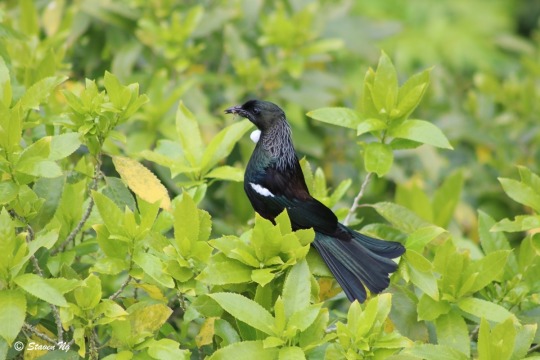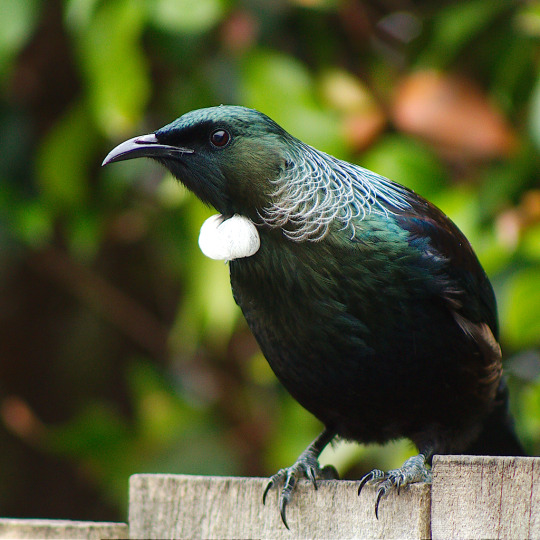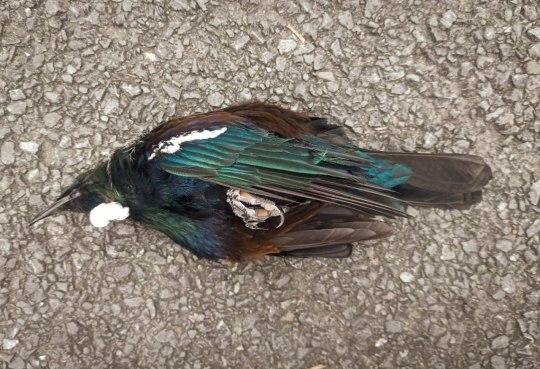#prosthemadera
Explore tagged Tumblr posts
Text

Tūī (Prosthemadera novaeseelandiae), family Meliphagidae, order Passeriformes, New Zealand
photograph by Jimmy Lee
543 notes
·
View notes
Text
The Great ACT-NSW-NZ Trip, 2023-2024 - Te Korowai o Mihiwaka / Orokonui Ecosanctuary
An ecological island reserve set up under Mt Cargill / Kapukataumahaka. Over 300 hectares of forest has been enclosed in mammal-proof fencing, and the site was then bombed with poison baits to kill any still inside the perimeter. It's now the home of kiwi, various seabirds, kākāriki, South Island kākā, South Island robin, South Island saddleback, kākā, bats, tuatara, jewelled geckos, pūkeko, paradise ducks and a breeding pair of the critically endangered South Island takahē.
Also the home of Aotearoa's tallest known tree, at 82.25 metres (269.8 ft) in height, although it's an Australian species - Eucalyptus regnans.
Some of those I've seen earlier on the trip, but there were also a few introduced species that flew in over the fence - if they wanted to keep insects out they probably would have had to go with the original conservation plan and take a fertiliser factory and turn it into a giant avairy.
Mt Cargill is a remnant of the enormous extinct Dunedin Volcano that forms the bulk of the landscape in the Dunedin area.






















#Orokonui Ecosanctuary#ecological island reserve#endangered species#new zealand bird#takahē#kākā#kiwi#tuatara#Badumna#Desidae#australian spider#Beard Lichens#Usnea#Parmeliaceae#Red Damselfly#Xanthocnemis#new zealand damselfly#Coenagrionidae#Tūī#Prosthemadera#Meliphagidae#Priocnemis#Pompilidae#Flax Window-Maker#Orthoclydon#Geometridae#Flax Notcher Moth#Ichneutica#Noctuidae#Kākā
2 notes
·
View notes
Text

Tui (Prosthemadera novaeseelandiae) - Zealandia, Wellington, New Zealand
0 notes
Text

A little sketch of a tui.
Entry for my sideblog @artist-quests, specifically for this one.
#art#my art#traditional art#coloured pencils#sketches#wildlife art#birblr#archosaurs#dinosaurs#theropods#coelurosaurs#maniraptorans#paravians#birds#passeriformes#prosthemadera novaeseelandiae#tui#queue
9 notes
·
View notes
Text

Tūī (Prosthemadera novaeseelandiae) on a flax flower in Victoria Esplanade, Palmerston North, Aotearoa. Photo by Geoff McKay.
99 notes
·
View notes
Text
Great Backyard Bird Off - New Zealand (poll 1)


Bird Info & Submission Reasons
Tahou / Silvereye (Zosterops lateralis)
Also found in Australia
"They are so cute and full of life. I have many fond memories of seeing them in trees around my childhood neighborhood and now my parents have built some feeders just for them (they're supposed to be for all birds but they're too scary for the mynahs and sparrows apparently). I also like that they self-introduced to New Zealand"
"I see them a lot in my backyard. They're very cute. Also I think it's neat that they're a recent arrival to my home country (their Māori name translates to "stranger/new arrival") and that they introduced themselves."
Tūī (Prosthemadera novaeseelandiae)
"i love tūī! i see them a lot when my tree is fruiting, and i like their colours and how they sound"
"Pretty common where I live (I see them basically every day). Their calls are very diverse (they can even mimic human speech). Also they have very pretty plumage. Not the politest of birds but I still love them."
"Aotearoa (new zealand) bird I see all the time"
"They have a very nice song and are native to Aotearoa"
Image Sources: Anon (Anonymous), Tui (Max Chalfin-Jacobs)
#Great Backyard Bird Off#bird poll#animal poll#New Zealand birds#oceania birds#australasian birds#Aotearoa birds#Aotearoa#Zelandia#silvereye#tahou#tui
28 notes
·
View notes
Text

[https://www.inaturalist.org/observations/42813939] Tūī || Prosthemadera novaeseelandiae Observed in New Zealand Least Concern in location of observation
28 notes
·
View notes
Text

Tūī (Prosthemadera novaeseelandiae), Wellington, New Zealand
2 notes
·
View notes
Text
hummingbirds, sunbirds & honeyeaters
Sunbirds (Nectariniidae)
the 'Hummingbirds' of Africa and Asia (and also Australasia)

*see below for species names*
Similarities between hummingbirds and sunbirds:
Brilliantly colored males, often iridescent
Sexually dimorphic females with duller plumage
Long, curved bills and specialized tongues adapted for efficient nectar feeding
Feed primarily on nectar but supplement diets with insects and spiders (especially for their young)
Prefer long, tubular flowers in red or orange hues
Important flower pollinators, aiding ecosystem biodiversity.
Can enter torpor to conserve energy
Short wings enable rapid flight; hummingbirds excel at hovering, sunbirds primarily perch
Highly active feeders, often territorial over high-quality nectar sources
Despite these similarities, sunbirds and hummingbirds are not very closely related. In fact, hummingbirds are more closely related to swifts and sunbirds are more closely related to crows — so the striking similarities between these two groups of tiny, colorful birds are analogies that evolved through convergent evolution.
This concept also applies with honeyeaters.
----
Honeyeaters (Meliphagidae)
the 'Hummingbirds' of Australia (more accurately Australasia)

*see below for species names*
What is unique about the honeyeaters is the evolutionary development of their tongue and beak. The tongue is long and has a brush-tip, fringed with bristles and works like a paint brush to soak up nectar by capillary action. The upper mandible then compresses any liquid out when the bill is closed. An operculum over their nares protects their nasal cavity from pollen.
Some differences between hummingbirds and honeyeaters:
Less nectarivorous and more insectivorous than hummingbirds
Supplement their diet with insects, but also occasionally fruits (hummingbirds almost never do)
Mostly larger in size
Perch while feeding; some hover hummingbird-style
Often flock while feeding
Territorial defence of flowers seems less common
Here's an interesting study about honeyeaters
----
Some more interesting stuff:

Highly recommend to read more
Honeyeaters have curved beaks and a highly specialized, extendable, brush-tipped tongue with a pointed tip; sunbirds have long curved-downward beaks and brush-tipped tube-shaped tongues; hummingbirds typically have straight or downward curving beaks and tongues with hairs at the end to help them sip nectar.
Figure 1: 1 Palestine Sunbird, Israel; 2 Malachite Sunbird, South Africa; 3 Green-headed Sunbird, Uganda; 4 Northern Double-collared Sunbird, Uganda; 5 Beautiful Sunbird, Ghana; 6 Mrs. Gould’s Sunbird, India; 7 Bronze Sunbird, Tanzania; 8 Orange-breasted Sunbird, South Africa; 9 White-breasted Sunbird, South Africa; 10 Olive-backed Sunbird, Australia; 11 Southern Double-collared Sunbird, South Africa; 12 Green Sunbird, Uganda; 13 Souimanga Sunbird, Madagascar; 14 Collared Sunbird, South Africa; 15 Blue-headed Sunbird, Uganda; 16 Malagasy Green Sunbird, Madagascar; 17 Olive-bellied Sunbird, Ghana; 18 Green-tailed Sunbird, Thailand; 19 Copper Sunbird, Ghana; 20 Eastern Crimson Sunbird, Thailand; 21 Green-throated Sunbird, Uganda;��22 Streaked Spiderhunter, Thailand; 23 Tacazze Sunbird, Ethiopia; 24 Red-chested Sunbird, Uganda; 25 Black-throated Sunbird, Thailand; 26 Regal Sunbird, Uganda; 27 Purple Sunbird, India
Figure 2: (a) crow honeyeater1 (Gymnomyza aubryana), (b) barred honeyeater1 (Gliciphila undulata), (c) New Holland honeyeater2 (Phylidonyris novaehollandiae), (d) tūī1 (Prosthemadera novaeseelandiae), (e) white-eared honeyeater3 (Nesoptilotis leucotis), (f) yellow-faced honeyeater1 (Caligavis chrysops), (g) crescent honeyeater1 (Phylidonyris pyrrhopterus), (h) noisy miner2 (Manorina melanocephala), (i) eastern spinebill1 (Acanthorhynchus tenuirostris), (j) New Caledonian myzomela1 (Myzomela caledonica), (k) white-plumed honeyeater1 (Ptilotula penicillata), (l) New Caledonian friarbird1 (Philemon diemenensis), (m) dusky myzomela2 (Myzomela obscura), (n) dark-brown honeyeater1 (Lichmera incana), (o) yellow wattlebird1 (Anthochaera paradoxa), (p) yellow honeyeater2 (Stomiopera flava), (q) bell miner3 (Manorina melanophrys), (r) white-naped honeyeater3 (Melithreptus lunatus), (s) white-fronted chat2 (Epthianura albifrons), (t) spiny-cheeked honeyeater3 (Acanthagenys rufogularis). Image credits: Matthias Dehling, Eleanor Hay, Steven Chown
#bird#ornithology#wild birds#sunbird#hummingbird#honeyeater#Nectariniidae#Meliphagidae#Trochilidae#such tiny yet magnificent beasts#wildlife#nature
3 notes
·
View notes
Text



Tūī | Tui
Prosthemadera novaeseelandiae
New Zealand endemic
39-35 John Downs Drive, Browns Bay, Auckland 0630
7PJJ+JHM Auckland
-36.7184190, 174.7314280
panoramic view in comments
0 notes
Note
i know it sounds silly but i think with enough of a uproar we might make the ethics committee consider letting you see your daughter -
(@prosthemadera-angel)
I hope so. I miss that kid so damn much.
I know that this universe’s me was a dick, and I hope he wasn’t that way to her- but if he was, maybe I can help make up for some of it.
3 notes
·
View notes
Text

Tūī (Prosthemadera novaeseelandiae), family Meliphagidae, order Passeriformes, New Zealand
photograph by Jonathan Harrod
365 notes
·
View notes
Text
youtube
The botanist Patrick Blanc, inventor of the Vertical Garden (Mur Végétal) takes you to a Field Trip in New Zealand, "The Land of the Long White Cloud" - Chapter 1 : Northern Island Filmed & produced by Pascal Héni Paspat 2013 Plant species list : Rhabothamnus solandri, Cyathea medullaris, Cordyline banksii, Lycopodium deuterodensum, Cordyline banksii, Agathis australis, Collospermum hastatum, Pseudopanax arboreus, Freycinetia banksii, Cyathea medullaris, Trichomanes reniforme, Dracophyllum latifolium, Knightia excelsa, Phyllocladus trichomanoides, Tui : Prosthemadera novaeseelandiae, Phormium tenax, Ripogonum scandens, Hymenophyllum sp., Schefflera digitata, Hedycarya arborea, Schistochila balfouriana, Hypnodendron sp., Blechnum fraseri, Elatostema rugosum, Rhopalostylis sapida, Blechnum novae-zelandiae, Pseudopanax crassifolius, Rubus cissoides, Knightia excelsa, Pseudocyphellaria cf. homeophylla, Blechnum chambersii, Metrosideros excelsa, Metrosideros robusta, Metrosideros perforata, Lycopodium (Huperzia) varium, Pseudopanax crassifolius, Rubus cissoides, Brachyglottis bidwillii, Gaultheria depressa var. novae-zelandiae, Dracophyllum recurvum, Hebe (Veronica) tetragona, Celmisia incana, Wahlenbergia pygmaea, Olearia arborescens, Dracophyllum subulatum, Dracophyllum recurvum, Celmisia spectabilis, Pimelea buxifolia, Parahebe (Veronica) hookeriana, Nothofagus solandri var. cliffortioides, Astelia fragrans, Sticherus cunninghamii, Coriaria pteridoides, Pseudopanax colensoi, Cordyline indivisa, Dracophyllum subulatum, Raoulia albo-sericea, Drosera spathulata, Hebe (Veronica) salicifolia, Dendroligotrichum (Polytrichum) tongariroense, Pterostylis patens, Hebe (Veronica) venustula, Olearia arborescens, Podocarpus nivalis, Cordyline cf. pumilio, Cordyline australis, Pseudopanax crassifolius, Rubus squarrosus, Macropiper (Piper) excelsum, Solanum laciniatum, Elatostema rugosum, Microsorum pustulatum, Calystegia tugoriorum, Nothofagus fusca, Cortaderia sp., Phormium cookianum, Cordyline australis, Urtica ferox, Parsonsia heterophylla, Dacrycarpus dacrydioides, Prumnopitys taxifolia
0 notes
Text

Tui (Prosthemadera novaeseelandiae) in New Zealand by Martin Barwood. https://www.instagram.com/martinbarwood/
36 notes
·
View notes
Text
Storm Hawks Bird OC Challenge - November 2022
Hey Storm Hawks! Spook month is over, but I've got another bird for you. This month we're looking at the Tūī, aka the New Zealand Honeyeater (Prosthemadera novaeseelandiae)!

The tūī (the name is of Māori origin) is a large honeyeater, a passerine bird that reaches about 11-13 inches in length. Native to New Zealand, they prefer broadleaf forest habitats at low altitudes, but they've been known to reach heights of 1500 metres. Males are known to be very territorial and aggressive, prone to chasing other birds out of their territory by flapping their wings and making souns akin to human profanities.
Their usual diet is nectar, but they also eat fruits and insects. A popular flower in their diet is New Zealand flax, and they're the main pollinator of flax, kōwhai, kaka beak and some other plants. These birds are known for their range of vocalisations, akin to parrots, and can be found mimicking car alarms, advertising jingles and shattering glass among other things.
I look forward to this month's entries! The deadline this month is Saturday the 26th. As always, rules and a few extra images, including an optional guide colour palette are under the cut.
Minimum requirements for drawn entries to be put in the winner's vote are a name, occupation, the character's home/birth Terra and at least one paragraph (or about 100 words) of written backstory.
Minimum requirements for written (i.e. written dossiers without art, or mini-fics for the character) are 500 words including backstory and appearance. Feel free to make a mini-fic out of this challenge, I'll make sure to link it with the final collage as well.
Entrants who are part of the Storm Hawks discord server will have the chance of getting a custom role for the next month! If you’re not part of the discord server, please ask for an invite if you’re interested.
You're not expected to create a character from scratch for this challenge. If you've got an older character concept that's been collecting dust or that you'd like to take the opportunity to revamp, feel free! The goal of this challenge is to inspire people.
Make sure to tag me in your entries and also DM me with a link to your entry. Tumblr is not always reliable about notifications for this sort of thing, and I don't want to risk missing anyone's entries, so better safe than sorry.
The group collage of entries, and the winner's vote are opt-in. Participation of those parts of this challenge are not mandatory.
The winner of the vote will receive a free sketch piece of their character from me.



#storm hawks#storm hawks oc challenge#storm hawks oc#nerd corp storm hawks#storm hawks bird oc challenge#oc challenge#storm hawks bird challenge#bird oc challenge#storm hawks fanart#colour palettes#colour palette#colour inspiration#colour inspo
25 notes
·
View notes
Photo

tūī bird (Prosthemadera novaeseelandiae), from New Zealand, with its trademark cravat.
photo s. mosdell (creative commons)
#bird#birds#birdwatching#birding#birb#birbs#birdblr#birblr#nature photography#wildlife photography#bird photography#ornithology#tui#new zealand#iridescent#shiny
11 notes
·
View notes